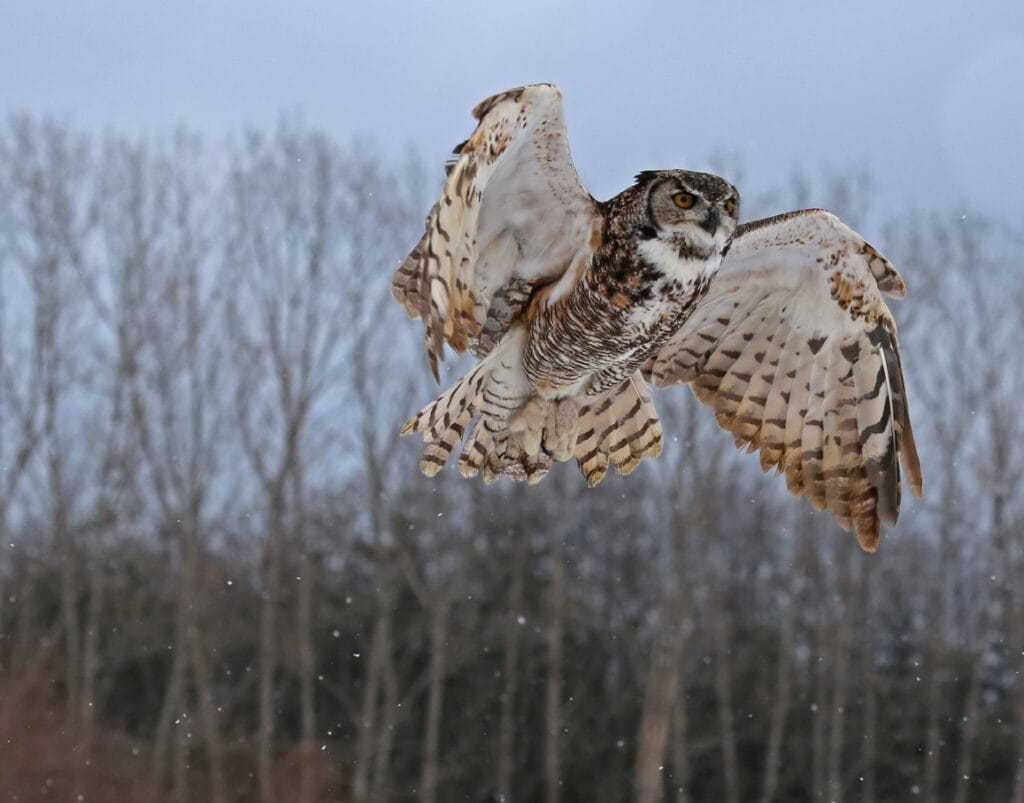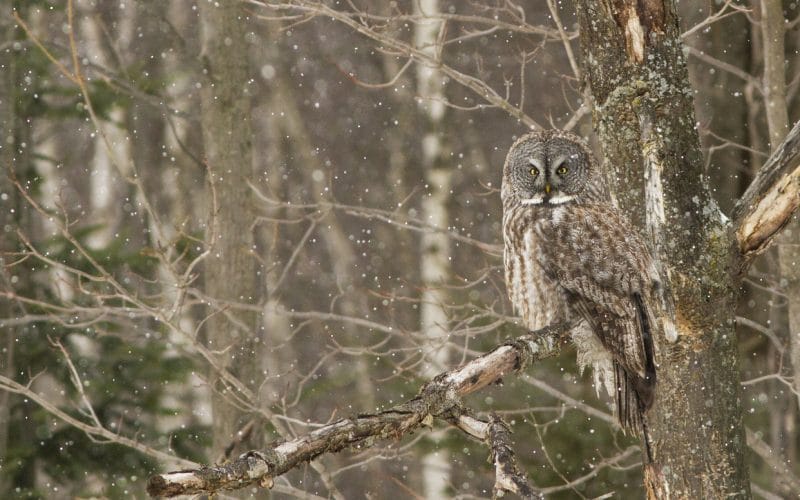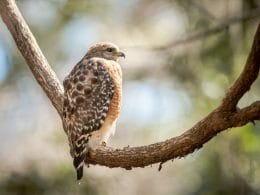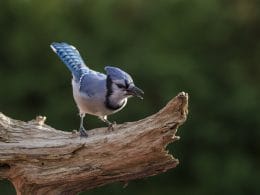Pennsylvania is known for many things, most famously its coal industry and railroads. It’s also known for its vast mushroom production and its historical significance, being the state that witnessed the Declaration of Independence in 1776.
But most importantly, Pennsylvania is known for its endless forestlands and woody areas. In fact, its name translates to Penn’s Woods, which gives you an idea of how many forests the state possesses.
Enjoying nearly 2 million acres of forests and more than 300,000 acres of parks, nine species of owls call Pennsylvania home.
Here’s a definitive guide if you want to know more about owls in Pennsylvania.
1. Barn Owl

- Scientific Name: Tyto furcata
- Length: 12.6 – 15.7 inches
- Weight: 15 – 22 ounces
- Wingspan: 42.1 – 43.5 inches
Barn Owls live in all of the US states except Alaska, so it’s no wonder there’s plenty of them in Pennsylvania. Granted, they’re classified as species of special concern in the state, but their numbers are rising.
In the Keystone State, you’ll see them commonly in the Southern areas. They live in grassland areas and prefer to take abandoned barns for nests, which explains their names.
Top Tip: Your best chance at sighting Barn Owls is from March to May. That’s their breeding season, and they’ll be at their most active trying to find mates to breed with. However, it’s worth noting that these owls are strictly nocturnal. They seldom appear during the day, so you better watch for them at night.
Beware, though. Those owls have white faces that look like ghosts in the night. Spooky, isn’t it?
Among other species, Barn Owls aren’t large, making them prone to being eaten by larger ones. Their most notorious predator is the Great Horned Owl, the deadliest owl on earth. Other than that, they themselves feed on mice, voles, and small rodents.
2. Great Horned Owl

- Scientific Name: Bubo virginianus
- Length: 18 – 25 inches
- Weight: 49 – 55 ounces
- Wingspan: Approximately 55 inches
The Great Horned Owl is classified as the deadliest on earth, and it’s for all good—or not so good—reasons. They’re opportunistic eaters, which means they’ll eat anything they can land as long as it contains meat. Be it an unsuspecting raccoon, an innocent vole, or even a domestic cat going about its day; no one is safe from a Horned fellow.
Other than their feeding habits, Great Horned Owls are known for their protective, territorial instincts. They hoot fiercely when their territory is threatened, and they’ll defend it with everything they got.
In Pennsylvania, Great Horned Owls mainly stay in mixed woodlands, but you can see them in the majority of the state. They’re a non-migratory breed, with only stray owls living in the North migrating for a warmer climate.
Thanks to their size, Great Horned Owls are at the very top of the food chain. They don’t have any predators that may feed on them, so their numbers aren’t expected to go lower anytime soon.
3. Short-eared Owl

- Scientific Name: Asio flammeus
- Length: 13 –17 inches
- Weight: 7.3 – 17 ounces
- Wingspan: 33 – 43.5 inches
Short-eared Owls are best known for the tiny tufts on their heads. They’re hardly visible, so you may not see them except if you look close enough. You’ll have to identify them using their brown feathers and wide eyes surrounded by black areas.
These owls are common near the Northern regions of Pennsylvania. You may see them in the Southern areas when they’re outside of their breeding season.
Short-eared owls are among the few species that appear during the day. They may appear when the sun is out, courting rituals. Meanwhile, during nighttime, they go hunting for prey. They mainly feed on mice, squirrels, and similar small rodents.
The feeding habits of short-eared owls may throw you off. These aggressive birds catch their prey, remove its head, cut off its wings if it’s a bird, and then swallow it whole. That’s not a sight you’d like to see!
4. Long-eared Owl

- Scientific Name: Asio otus
- Length: 14 – 16 inches
- Weight: 9 ounces
- Wingspan: 35.5 – 39 inches
Long-eared Owls look like they belong somewhere in a horror movie, and the large tufts on top of their heads aren’t really helping. Donning wide yellow eyes and hollowed-out faces, these fellows are scary. They also embrace their nature, spending their time bullying smaller birds and stealing their food.
They don’t only steal food but nests as well. Long-eared owls don’t like to build their own nests, so they resort to stealing the ones made by ravens or crows.
These owls live in large colonies, so they need wide spaces to live. They mostly choose woodlands and open grasslands; you can see them in Pennsylvania in the Northwestern region. They’re not as common in the rest of the state.
Top Tip: When you see them, strain your ears for their loud call. It sounds like a screech, and it can be heard from a considerable distance away.
It’s also worth noting that long-eared owls are migratory, so they leave Pennsylvania during their breeding season. They’re less common in the state during this period, except for some stray birds.
5. Northern Hawk Owl

- Scientific Name: Surnia ulula
- Length: 14 – 18 inches
- Weight: 11 – 12 ounces
- Wingspan: 18 inches
No, the Northern Hawk Owl isn’t actually a hawk, nor does it look like one, although many people believe it has this name because it looks like a hawk. As a matter of fact, it gained its name because its behavior matches that of a hawk.
For example, Northern Hawk Owls hunt and are most active during the day. Most other species are nocturnal, so that’s one difference. On top of that, these hawk owls fly like hawks. They take long glides, then flap their wings slowly. On the other hand, most owls fly silently without flapping their wings because they’re large enough to keep them afloat.
Northern Hawk Owls also hunt like hawks, hovering low over grasslands, looking for prey to eat. They don’t perch silently as most owls do.
These owls can live up to 16 years, which is more than the average for owls. They mostly live in mixed woodlands, and they prefer to stay near swamps and waterways. In Pennsylvania, you have better chances of seeing them in the winter, particularly in the Northern regions.
Take care, though, because Northern Hawk Owls are known to be non-forgiving when their territories are threatened. It’s better to keep your distance.
6. Northern Saw-whet Owl

- Scientific Name: Aegolius acadicus
- Length: 7 – 9 inches
- Weight: 4 ounces
- Wingspan: 16 – 24 inches
Only a few owl species can be regarded as adorable, and Northern Saw-whets are among those. With their petite bodies, wide eyes, and cute faces, they’re nothing short of pretty. Unfortunately, their size puts them at the end of the food chain, and they’re frequently eaten by other raptors and larger owl species.
That’s also why they only eat small birds and rodents. You’ll rarely find a saw-whet chasing a rabbit or a larger animal. Those are left for larger species, such as Snowy and Great Horned Owls.
Author Note: These owls spend the whole year in the Keystone State, but they stick to the Northwestern regions. You may see them in the rest of the state, but it’ll only be outside of their breeding season.
It’s also worth noting that Northern Saw-whet Owls prefer to stay alone. You’ll rarely see them in pairs—maybe only during their breeding season.
Despite their small size, saw-whets are perfectly capable of hunting their prey. They only do it at night, aided by their impressive eyesight and incredible hearing sense. They stay on low perches, waiting for the prey to appear, before jumping and snatching it up in an instant.
7. Eastern Screech-Owl

- Scientific Name: Megascops asio
- Length: 6 – 10 inches
- Weight: 5.6 ounces
- Wingspan: 18 – 24 inches
The population of Eastern Screech-Owls is evenly distributed across Pennsylvania. Anywhere there are trees, you’ll find Eastern Screech-Owls. They love to hide in the nooks and crannies of trees, and they’re masterful camouflagers.
These owls are known for regularly using nest boxes. If you want to attract a breeding pair, you may put up a nest box in your backyard. If you hang it before their breeding season, there’s a high chance you’ll receive more than a pair.
Eastern Screeches are the most nocturnal owls in North America, meaning your chances of seeing them during the day are pretty much non-existent. However, you can use small birds to your advantage.
When titmice, jays, and chickadees are threatened by a screech owl, they’ll create a commotion to protect their young and warn other close birds. If you find a lot of small birds swooping around one area, giving out loud calls, there’s definitely an Eastern Screech-Owl hiding somewhere near.
You’ll find it easy to identify Eastern Screech-Owls. They have medium-sized tufts on top of their heads, and their bodies don a unique pattern of grey, brown, and white streaks.
8. Barred Owl

- Scientific Name: Strix varia
- Length: 19 – 20 inches
- Weight: 16.5 – 40.6 ounces
- Wingspan: 38 – 49 inches
If Barred Owls weren’t sharing the earth with us, they’d belong somewhere in a haunted house in an old horror movie. These owls bask in the aura of fear they have surrounding them, donning hallowed out faces and deep black eyes that pierce right through your soul.
Granted, Barred Owls aren’t only scary in terms of looks. They’re classified among the most dangerous birds on the planet, and it’s needless to say they’re among the most terrifying owls in North America.
Barred Owls mainly feed on rodents and average-sized birds. They’re known to prey on woodpeckers and smaller owls, and they stay near water swamps. Although the species is one of the most deadly, that doesn’t protect the owls from being eaten by Great Horned Owls.
In Pennsylvania, you can spot barred owls all year long in woodlands and close to coastlines. Think twice before getting too close because they may get aggressive if they feel a threat. Barred Owls won’t hesitate to attack humans if they see them as a threat.
Your chances of seeing barred owls are slim, though, because they’re only active during the night. You can see them in Pennsylvania’s western areas close to the Ohio border.
9. Snowy Owl

- Scientific Name: Bubo scandiacus
- Length: 25 – 29 inches
- Weight: 70.5 ounces
- Wingspan: 59 inches
The Snowy Owl is one of the most beautiful birds you can see in your lifetime, but it’s also one of the deadliest. It’s the largest owl species in North America, and it’s one of the most dangerous around the world.
Snowy Owls have entirely white bodies with some faint black streaks here and there. When they get older, their bodies get even whiter because they need to camouflage against the snow. Their color immensely helps them hide when they’re trying to catch their prey.
Author Note: Snowy Owls are excellent hunters because of the way they fly. Their wings don’t flap, thanks to their frilled edges. As a result, they stay silent, and their prey never sees them coming.
These owls can eat anything they find in their way, even if they’re arctic wolves. Their huge size helps them feast on anything, but their primary food is mice, voles, and arctic rabbits.
Snowy owls aren’t widespread in Pennsylvania. You may only spot them during the winter when the arctic tundra—their natural habitat—is too cold for them.
The Takeaway
Pennsylvania isn’t only beautiful for its collection of forests and woodlands, but it also acquires a nice variety of birds. If you’re into owls, you may be lucky to run into a Snowy owl hiding somewhere or a Northern hawk owl seeking food.
Barn Owls and Great Horned Owls are the most common, so it shouldn’t be too hard to sight them.
Remember to keep a safe distance and capture a lot of paragraphs. You’ll want to show them to your friends and brag later on!
FAQ
Audubon recommends trying the Loyalsock State Forest to find the Northern Saw-whet Owl.
The owls on our list are common in certain areas. There is no one species that is common state-wide.
To find out where recent sightings of owls have been, try eBird. You can search for the latest sightings or particular species or what has been seen in a certain area.










